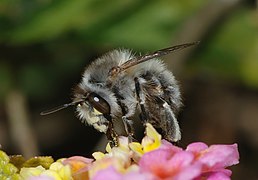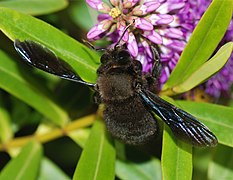Ápidos
| Ápidos Apidae | |||||||||||||||
|---|---|---|---|---|---|---|---|---|---|---|---|---|---|---|---|
 Bombus sp. | |||||||||||||||
| Clasificación científica | |||||||||||||||
| |||||||||||||||
| Subfamilias | |||||||||||||||
| |||||||||||||||
- Artigo principal: Abella.
A dos ápidos (Apidae) é unha familia de insectos da orde dos himenópteros, suborde dos apócritos, unha das numerosas comprendidas na superfamilia dos apoideos.
Constitúe un numeroso grupo de abellas que inclúe a abella común (Apis mellifera), a máis coñecida, as abellas sen aguillón, as abellas parasitas, e os abesouros, ademais doutros grupos menos coñecidos, como as abellas albanel ou osmia.[1][2]
Moitas das súas especies son valiosas polinizadoras en hábitats naturais e nos cultivos agrícolas.[3]
Taxonomía
[editar | editar a fonte]Descrición
[editar | editar a fonte]A familia foi descrita en 1802 polo entomólogo francés Pierre André Latreille.
Etimoloxía
[editar | editar a fonte]O nome científico Apidae está formado polos elementos do latín científico ap- e -ĭdea. O primeiro é a raíz do nome do seu xénero tipo, Apis, e o segundo é o sufixo empregado para formar os nomes das familias de animais.[4]
Subfamilias
[editar | editar a fonte]A familia comprende tres subfamilias:[5]
- Apinae, que comprende as abellas propiamente ditas, e entre elas as abellas produtoras de mel.
- Nomadinae, as abellas parasitas.
- Xylocopinae, as chamadas abellas carpinteiras.
Galería
[editar | editar a fonte]Notas
[editar | editar a fonte]- ↑ Family Apidae en BugGuide.
- ↑ Danforth, Bryan N.; Cardinal, Sophie; Praz, Christophe; Almeida, Eduardo A. B.; Michez, Denis (2013). "The Impact of Molecular Data on Our Understanding of Bee Phylogeny and Evolution". Annual Review of Entomology 58 (1): 57–78.
- ↑ Michener, Charles D. (2007): The bees of the world. Baltimore, Maryland: The Johns Hopkins University Press. ISBN 978-0-8018-8573-0.
- ↑ Apidae no Merriam-Webster Dictionary.
- ↑ Apidae no ITIS.
Véxase tamén
[editar | editar a fonte]| Wikimedia Commons ten máis contidos multimedia na categoría: Ápidos |
| Wikispecies posúe unha páxina sobre: Ápidos |
Bibliografía
[editar | editar a fonte]- Aguiar, Alexandre P. et al. (2013): "Order Hymenoptera". En Zhang, Z.-Q. (ed.): "Animal Biodiversity: An Outline of Higher-level Classification and Survey of Taxonomic Richness (Addenda 2013)". Zootaxa 3703: 1–82.
- Arnett, R. H. Jr. (2000): American insects, 2ª ed. Boca Ratón, Londres, Nova York, Washington DC: CRC Press. ISBN 0-8493-0212-9.
- Borror, D. J., DeLong, D. M. & Triplehorn, C. A. (1976): An introduction to the study of insects, 4ª ed. Nova York, Chicago: Holt, Rinehart and Winston. ISBN 0-0308-8406-3.
- Grimaldi, D. & Engel, M. S. (2005): Evolution of the Insects. Cambridge: Cambridge University Press. ISBN 978-0-5218-2149-0.
- Huber, John T. (2009): "Biodiversity of Hymenoptera". Capítulo 12. En Robert G. Foottit & Peter H. Adler: Insect Biodiversity: Science and Society. Hoboken, New Jersey: Blackwell Publishing. ISBN 978-1-4051-5142-9.
- O'Toole, Christopher & Raw, Anthony (1999): Bees of the world. Londres: Cassell & Co. ISBN 0-8160-5712-5.
- Sharkey, Michael J. (2007): "Phylogeny and Classification of Hymenoptera". Zootaxa 1668: 521–548.
- Sharkey, M. J.; Carpenter, J. M & Vilhelmsen, L. (2012): "Phylogenetic relationships among superfamilies of Hymenoptera". Cladistics 28 (1): 80–112.
- Michener, Charles D. (2007): The Bees of the World. 2ª ed. Baltimore: The Johns Hopkins University Press. ISBN 978-0-8018-8573-0.
- Vilhelmsen, Lard (2001): "Phylogeny and classification of the extant basal lineages of the Hymenoptera (Insecta)". Zoological Journal of the Linnean Society 131: 393–442.
Outros artigos
[editar | editar a fonte]Ligazóns externas
[editar | editar a fonte]- Bees. Apidae na EOL.






